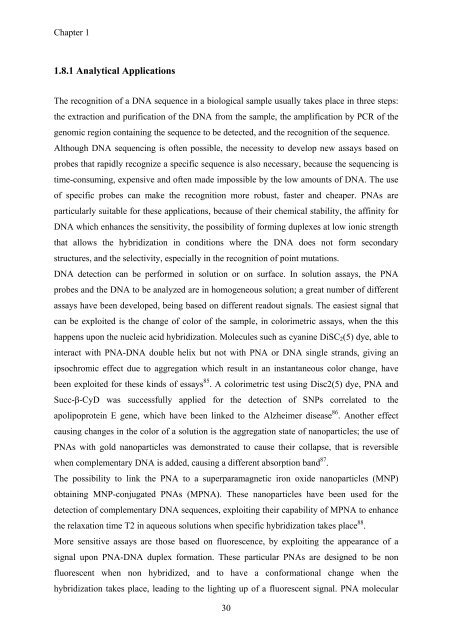View - DSpace UniPR
View - DSpace UniPR
View - DSpace UniPR
You also want an ePaper? Increase the reach of your titles
YUMPU automatically turns print PDFs into web optimized ePapers that Google loves.
Chapter 1<br />
1.8.1 Analytical Applications<br />
The recognition of a DNA sequence in a biological sample usually takes place in three steps:<br />
the extraction and purification of the DNA from the sample, the amplification by PCR of the<br />
genomic region containing the sequence to be detected, and the recognition of the sequence.<br />
Although DNA sequencing is often possible, the necessity to develop new assays based on<br />
probes that rapidly recognize a specific sequence is also necessary, because the sequencing is<br />
time-consuming, expensive and often made impossible by the low amounts of DNA. The use<br />
of specific probes can make the recognition more robust, faster and cheaper. PNAs are<br />
particularly suitable for these applications, because of their chemical stability, the affinity for<br />
DNA which enhances the sensitivity, the possibility of forming duplexes at low ionic strength<br />
that allows the hybridization in conditions where the DNA does not form secondary<br />
structures, and the selectivity, especially in the recognition of point mutations.<br />
DNA detection can be performed in solution or on surface. In solution assays, the PNA<br />
probes and the DNA to be analyzed are in homogeneous solution; a great number of different<br />
assays have been developed, being based on different readout signals. The easiest signal that<br />
can be exploited is the change of color of the sample, in colorimetric assays, when the this<br />
happens upon the nucleic acid hybridization. Molecules such as cyanine DiSC 2 (5) dye, able to<br />
interact with PNA-DNA double helix but not with PNA or DNA single strands, giving an<br />
ipsochromic effect due to aggregation which result in an instantaneous color change, have<br />
been exploited for these kinds of essays 85 . A colorimetric test using Disc2(5) dye, PNA and<br />
Succ-β-CyD was successfully applied for the detection of SNPs correlated to the<br />
apolipoprotein E gene, which have been linked to the Alzheimer disease 86 . Another effect<br />
causing changes in the color of a solution is the aggregation state of nanoparticles; the use of<br />
PNAs with gold nanoparticles was demonstrated to cause their collapse, that is reversible<br />
when complementary DNA is added, causing a different absorption band 87 .<br />
The possibility to link the PNA to a superparamagnetic iron oxide nanoparticles (MNP)<br />
obtaining MNP-conjugated PNAs (MPNA). These nanoparticles have been used for the<br />
detection of complementary DNA sequences, exploiting their capability of MPNA to enhance<br />
the relaxation time T2 in aqueous solutions when specific hybridization takes place 88 .<br />
More sensitive assays are those based on fluorescence, by exploiting the appearance of a<br />
signal upon PNA-DNA duplex formation. These particular PNAs are designed to be non<br />
fluorescent when non hybridized, and to have a conformational change when the<br />
hybridization takes place, leading to the lighting up of a fluorescent signal. PNA molecular<br />
30
















